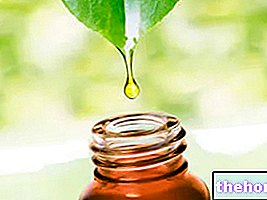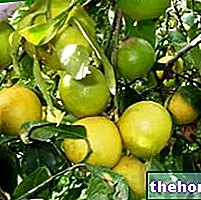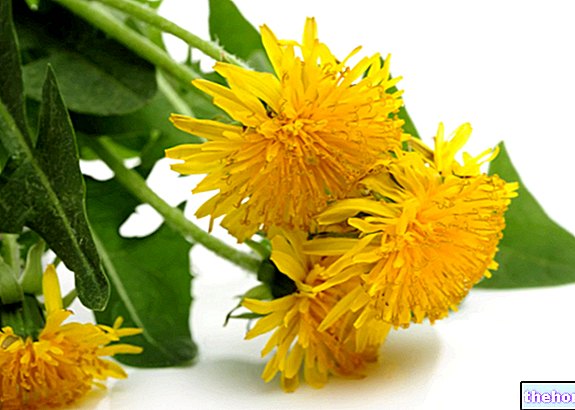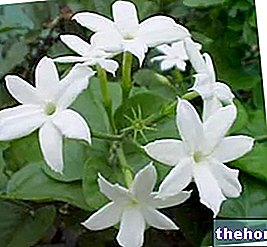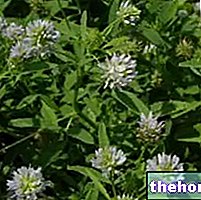See also: slimming pills
Slimming products
The herbal market offers a vast assortment of products designed to assist a low-calorie diet: draining infusions and herbal teas, fluid concentrates, capsules and slimming tablets are undoubtedly the favorite formulations.
Unlike herbal teas, slimming tablets are preferred because they are more practical: in fact, they do not require waiting times - such as infusion - and the consumer has the perception, sometimes unfounded, that the tablet "has more effect".

How to use
A good herbalist must be able not only to recommend the most suitable product for the patient, but also to indicate the correct way to use it: for example, the expert should make it clear to the client that the slimming tablets must be taken. with a consistent amount of water, quantified in no less than two glasses. Water is in fact an integral part of the herbal product: if, for example, the slimming tablets are characterized by mucilage, water is essential to form a sort of gel that gives a feeling of satiety. In addition, the tablet must be taken at least ten minutes before a meal, in order to allow the mucilage to absorb all the necessary water.
Active principles
The slimming tablets could be made up of glucomannan, cellulose, opuntia, marshmallow, flaxseed and linden: let's see, now, what activities are connected to these drugs of herbal interest.
- Glucomannan: is a vegetable fiber extracted from Amorphophallus konjac. Glucomannan is a high molecular weight polysaccharide, made up of glucose and mannose polymers; it is a gum that has the ability to reduce hunger as it adsorbs a lot of water, creating a gel in the stomach that induces a sense of satiety.
- Cellulose: represents a mix of xylar and extra-xylar fibers, and can derive from plant processing waste. Cellulose is used in slimming tablets as the fibrils pass into the gastric tract and are eliminated with the faeces. During this step, the cellulose is able to stimulate the lining cells of the intestine to produce mucus, making it easier for food to arrive in the intestinal tract.
- Opuntia ficus indica: the prickly pear cactus (cladodes) is rich in mucilages and heteropolysaccharides which, in the stomach, swell giving a feeling of satiety.
- Altea officinalis: the roots of this plant are rich in heteropolysaccharides that perform the same function as opuntia; in addition, there are phenols and polyacetylene compounds with a soothing and disinfectant action (for this reason, marshmallow is also found in products for l "oral hygiene).
- Tilia platyphillos: lime flowers are considered, rich in mucilage. In addition, lime is rich in phenyl propanes, terpenes and flavonoids with anxiolytic activity.
- Linum usatissimum: also flax seeds represent a source of mucilage, consequently they could replace the lime tree.
However, a herbal formulation of this type, designed to be an adjuvant to low-calorie diets, is not complete: in fact it causes swelling in the stomach. To solve this problem, we recommend a combined herbal product based on star anise and fennel: the essential oil of star anise (anethole) and fennel extract (fencone) have carminative properties, limiting the intestinal gas caused by fermentation. The combination of this product improves the activity expressed by the slimming tablets.
Select plant Fir Acacia Acerola Sorrel Yarrow Yarrow Yarrow Aconito Adatoda Garlic Agnocasto Agrimonia Alchemilla Alkekengi Aloe Altea Witch Hazel Ammi or Visnaga Pineapple Andrographis Anemone Pulsatilla Angelica Anise Star Anise Japanese Star Anise Bitter Orange Bitter Areca Arnica Harpagophytum Arpagophyte Artemisia Asteragus Basil Asparagus Asparagus Peruvian Asparagus Asparagus Asparagus Hawthorn Boldo Borage Shepherd's Purse Boswellia Bucco Butea superba Cocoa Coffee Cajeput Calamus Calamus Marigold Camedrio Chamomile Roman Chamomile Camphor Cinnamon Ceylon Maidenhair Capuchin Artichoke Cardamom Cardiac Thistle Asian Thistle Carvi Cascara Cassia Catecu Catha Cabbage Celandine Chicory Centaurea Cinnamon Cypress Celandine Chives Cypress Coca Cola Colchico Combreto Condurango Comfrey Coriander Cranberry Barberry American Chrysanthemum Cumin Turmeric Damiana Digital Dioscorea Drosera Dulcamara Dunalilella Echinacea Eder a Ephedra Elenio Eleutherococcus Helichrysum Evening primrose Horsetail Alfalfa Erica Euphrasia Erisimo Escolzia Eucalyptus Farfara Farfaraccio Calabar bean Fenugreek Fennel Phytolacca Frangola Ash Fumaria Japanese Mushrooms Galega Ganoderma lucidum Garcinia Cambogia Mulberry Gentian Broom Ginkgo Ginkgo Guipana Guipana Gynestra Ginkgo Hibelia Gymnasium Hibiscus Guarulp St. John's Wort Horse Chestnut Ispaghul Hyssop Jaborandi Kava kava Konjac Laminaria Cherry Laurel Lavender Lemongrass Lespedeza Lovage Icelandic Lichen Lemon Flax Lippia Licorice Lobelia Hops Maca Marjoram Maize Mallow Manna Marrubio Marrubio d "water Matè Melaleuca Meliloto American Lemon balm Myrtle Myrama Walnut Nutmeg Walnut vomica Olive tree Meadowsweet Ononide Opuntia Oregano Orthosiphon Nettle Poppy Papaya Parietaria Feverfew Passiflora Chilli Perilla Periwinkle Phyllanthus Plantain Picrorhiza Pilosella Pino Pisci dia Podofillo Polygala Grapefruit Parsley Psyllium Pueraria mirifica Butcher's broom Pygeum Quassia Oak Rhubarb Ratania Rauwolfia currant Castor bean Rhodiola Rosehip Rosemary Rue Willow Sarsaparilla Sage Elderberry Sassafras Sedum Ergot Senna Serenoa Repens Soybean Solidago Tansy Taraxus Tamarind Tamarind Tamarind Tamarind Tamarindo Ursina Valerian Vanilla Mullein Verbena Veronica Viburnum Vinca Pansy Mistletoe Vine Withania Yohimbe Saffron Ginger Pumpkin Select disease Juvenile Acne Rosacea Tinnitus Tinnitus Aerophagia Tendon Affections Afonia Aphthae Algias Functional Halitosis Breastfeeding Allergy Anemia Anguish Anxiety Arteriosclerosis Asthrosis Asthrosis Arthritis Arthritis Men Sex Woman Blepharitis and Conjunctivitis Eye bags Bronchitis Gallstones Kidney stones Salivary stones Baldness Androgenetic Candida Fragile hair Caries Headache Cellulitis Motion sickness Cystitis C limaterio Cholecystopathy High cholesterol Ulcerative colitis Colonoscopy Contusions Hematoma Convalescence Couperose Depression Dermatitis Diaper dermatitis Diabetes Diarrhea Erectile dysfunction Dyslipidemia Dysmenorrhea Dyspepsia Disturbances of vision Hemorrhoids Epistaxis Herethism Heart disease Fever Fibromyalgia Gastro-intestinal disease Flatulence Hypertension Fibromyalgia Gastrointomnia Jaundice Laryngitis Renal lithiasis Toothache Sore throat Thinness Menopause Meteorism Mononucleosis Alzheimer's disease Crohn's disease Nausea Vomiting Obesity Dark circles Onychomycosis Osteoporosis Dry skin Periarthritis Piorea Low pressure Prostatitis Psoriasis Colds Breast fissures Anal fissures Gastro-nasal rhinitis Senescence Premenstrual Syndrome Sinusitis Quit smoking Overweight Fatty liver Constipation Stomatitis Stress Cough Triglycerides high Ulcer Burns Nails Brittle flashes Heat Warts Dizziness Properties herbal Tanning Abortive adaptogenic Aphrodisiac bittering analgesic anesthetic anorectics analgesic antacid anti-allergic anti-asthmatic Antibiotic catarrh Anticellulitiche anticonvulsant Antidiaforetiche antidiarrheal edematous anthelmintic antiemetic Antiemorroidarie antiphlogistic Antiidrotiche Antinevrotiche Antioxidants antipyretic antirheumatic antiscorbutic Antiseptic antispasmodic anti-uric Aperitive Flavoring Astringent Balsamic Bechiche Capillarotrope Cardiotonic Carminative Cathartic Caustics Healing Cholagogues Choleretic Dyes Decongestants Deodorants Purifying Diaphoretic Cleansers Disinfectants Detoxifiers Thirst quenching Diuretics Exciting Emetics Emmenagogues Emollients Hemostatic Energies Hepatoprotectors Expectorants Eupepticus Moisturisers Galactosensitizers lanti Hypertensive Hypnotic Hypoglycemic Hypotensive Irritants Laxatives Soothing Narcotic Nerves Nutrients Odontalgic Pectoral Purgative Revulsive Remineralizing Refreshing Rubefacient Scialagoghe Sedative Soporifugas Sneezing Stomachic Stomatics Narcotic Vascular Tightenitis

